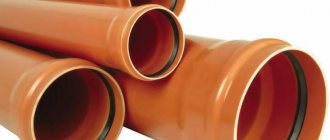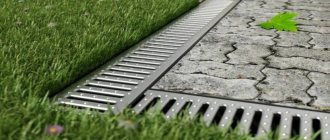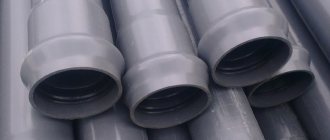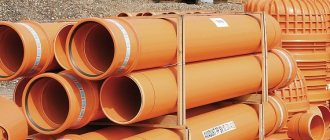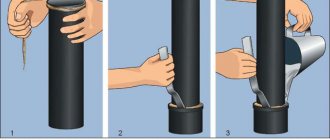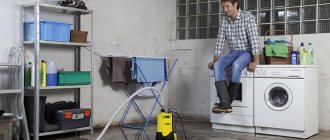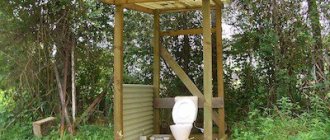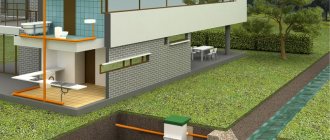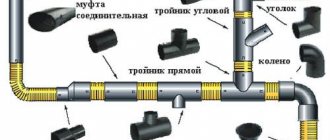Features of PVC sewer pipes
Plastic sewer pipes
PVC pipes are made from polyvinyl chloride. To improve the strength characteristics, additives are added to the mixture. The composite material produced under high pressure becomes durable, retains its shape well and can be subjected to static and dynamic loads.
Advantages:
- light weight with sufficient strength - PVC sewer can be assembled alone;
- do not rust, unlike metal products;
- more hygienic;
- exhibit acid resistance;
- reasonable cost;
- smooth internal walls, which several times reduces the likelihood of blockages and growths;
- There are not only straight-line products on sale, but also a wide selection of components, which allows you to assemble a pipeline of any configuration;
- no special equipment is required to install the system;
- have mounting recesses and grooves, which facilitates assembly;
- the price is 20-30% lower compared to products made from other materials;
- variety of standard sizes;
- easy cutting;
- do not conduct electric current;
- service life – 50 years.
Flaws:
- the material loses its properties under the influence of ultraviolet rays, so PVC pipes cannot be stored or installed in the sun;
- must be firmly secured so that the elements do not move;
- When installing external sewerage, the pipeline is insulated, since it is unstable to severe frosts and freezes. Operating temperature range – from -10 to +65 degrees;
- Internal sewerage may need insulation, since the pipes do not provide adequate sound insulation when passing through drains.
After heat treatment and extrusion of PVC during heating, a change in length of no more than 5% is allowed.
Advantages of plastic pipe
Plastic products have a number of undeniable advantages. These include:
- Corrosion resistance. Made from materials that do not react with destructive elements. The service life of plastic is less than that of cast iron, but still reaches 50 years.
- During operation, plastic pipes do not create much noise, since the smooth inner surface ensures the unhindered passage of water.
- The environmental friendliness of the material ensures safe use in domestic conditions.
- Low degree of thermal conductivity. This is a significant plus, since the hot water passing through the pipes does not cool down.
- Plastic is highly resistant to temperature changes and pressure changes.
- They are lightweight, which greatly simplifies the installation process. No welding is required to connect them. They are connected using special parts. The connections are ultimately reliable and sealed.
- Plastic products do not require maintenance in terms of corrosion protection. There is no need to paint them. Suitable for both open and indoor use.
Types of PVC pipes
Designs for free-flow sewerage
According to their purpose, PVC pipes are divided into internal and external. Elements for external sewerage are larger in diameter and more durable. They are made of thick plastic, there are varieties with stiffeners. Their tensile strength is up to 50 MPa. Load pressure – 6-16 bar.
Products for installation of internal sewage systems are smaller in diameter. They are installed indoors.
Pipes are divided into the following types:
- Non-pressure - the liquid moves by gravity at a speed of no more than 8 m/s.
- Pressure - pumps are installed in such systems to pump out wastewater. The elements are often of complex design and can withstand pressures of up to 10 atmospheres. Consequently, products must be stronger, which is why their cost is slightly higher.
- Corrugated – both strong and flexible. Suitable for installing external sewerage in hard-to-reach places. Stiffening ribs increase strength and resistance to external loads.
PVC products consist of 1-3 layers. The outer layer is unplasticized PVC (for pressure pipes). The intermediate layer of uPVC pipes used for external sewerage is a recycled foam material. The layers are connected in production through temperature exposure, resulting in a monolithic product. Thanks to the use of porous material, the weight of the pipeline is reduced.
One of the criteria for classifying structures is their rigidity. It is determined by the thickness of the wall: the larger it is, the greater the strength. This parameter depends on the diameter.
| Ring stiffness | SN-2 | SN-4 | SN-8 |
| Marking | L | N | S |
| Hardness degree | Lungs | Medium hardness | Hard |
| Laying depth | 0.8-2 m | 2-6 m | Up to 8 m |
| Wall thickness | 2.3 mm | 2.5-12.3 mm | 3.2-15.3 mm |
| Pressure | Up to 630 Pa | 600-800 Pa | 800-1000 Pa |
| Purpose | Can be laid under pedestrian zones and similar-purpose areas, where traffic is excluded. | A small transport load is allowed. | Suitable for organizing sewer networks in industrial areas where high traffic load is likely. |
Pressure components can withstand pressures of 6, 10 and 12.5 kg per cm2. depending on the type.
In addition to direct products, connecting elements - fittings - are required for sewer assembly. They are equipped with rubber seals that ensure the tightness of the entire system. The following types of connections are commercially available:
- reductions - for connecting segments that differ in diameter;
- couplings;
- tees and crosses for routing the pipeline in different directions;
- swivel fittings;
- audits;
- expansion pipes.
The fewer connecting elements, the stronger the system. Therefore, it is advisable to organize a sewer system with a minimum number of branches and branches. Turns at an angle of 90 degrees should also be avoided: the angle is formed with two 45-degree bends.
Characteristics of PVC pipes
PVC sewer pipes made from the same thermoplastic have:
Main technical characteristics of PVC pipes
- light weight;
- minimal thermal conductivity;
- absence of corrosive processes and chemical oxidation;
- durability (up to 50 years);
- preservation of shape after thermal exposure;
- dielectric properties, which eliminates the passage of current and the need to ground drains;
- thermal endurance from -25 to +65.
Thanks to the internal smooth surface, silting and accumulation of dirt on the walls is prevented, and there is no damage from the impact of solid particles moving along the drain. This is especially important for gravity (no pressure) systems. Polyvinyl chloride thermoplastic, on the basis of which PVC sewer pipes are made, after processing at high temperatures and the extrusion procedure, acquires improved properties - it retains its shape well. Polyvinyl chloride contains ethylene and stabilized chlorine. To improve the qualities of the material, various additives are added, and under high pressure a high-strength connection is obtained.
Standard dimensions of structures for external sewerage
Characteristics of PVC sewer pipes
Pipes for external sewerage are orange, painted throughout. You can purchase lengths:
- 0.5 m;
- 1m;
- 2 m;
- 3m;
- 6 m.
Purpose of sewer pipes depending on diameter:
- 110 mm is the minimum parameter. They are used to drain wastewater from individual private houses and cottages.
- 315 mm - capable of draining wastewater from several private houses.
- 630 - used for the construction of sewer mains.
Intermediate sizes: 125, 160, 200, 250, 500, 500 mm.
Options for elements for external sewerage:
- bends with two sockets;
- bends with angles of 15, 30, 45, 67 and 90 degrees;
- tees;
- couplings;
- check valves;
- single-plane crosses with an angle of 90 degrees;
- siphons.
Pipe cost
You now know the dimensions of a 110 mm sewer pipe. However, before purchasing, it is important to also inquire about the cost. This question is the most interesting part for the consumer. For a pipe with the mentioned diameter you will have to pay 165 rubles. per linear meter. Prices for PPE pipes will be almost three times higher, although with a greater set of advantages. In this case, we can say that there is an excess of advantages, but whether to pay for them is up to you.
The final price of the sewer system will be calculated with an eye to the installation of the system and sometimes adds unexpected somersaults to the estimate. For an initial assessment, you can take the option of calculating the construction of a sewerage system in a dacha. So, you will have to pay 1,500 rubles for pipes and their installation. The cost of a drainage well in the composition is 37,000 rubles. This includes two rings, pump installation, concrete and excavation work. Additional costs for laying the system, commissioning, transportation costs, backfilling the station and removing soil will cost 15,600 rubles.
Standard sizes of products for internal sewerage
Scheme of laying internal sewerage
The components for internal sewerage are made in gray color, so they cannot be confused with external pipes. If for some reason the gray shade does not suit you, there are white products on sale that look more presentable.
It is prohibited to install pipes for internal sewerage outside, as they do not have the necessary strength characteristics.
Standard diameters:
- 32 mm;
- 40 mm;
- 50 mm;
- 75 mm;
- 110 mm;
- 160 mm.
The length varies from 0.3 to 3 m. The wall thickness is from 1 to 3.2 mm.
It is important to know that PVC products are designed for the removal of wastewater at temperatures up to 70 degrees (with a short-term increase in temperature up to 95%) and pH from 2 to 12.
Element options:
- audits with a cover;
- tees with angles 67, 90 45 degrees;
- rotary bends with angles of 30, 45, 90 degrees;
- stop and full bore couplings;
- single-plane crosses with angles of 45 and 90 degrees;
- two-plane crosses with angles of 45 and 90 degrees;
- plugs;
- expansion pipes.
How to install a 110 mm pipe
The laying of sewer pipes is determined according to a certain technology. Compliance with it ensures high-quality functioning of the sewerage system. During installation, certain features should be observed and certain nuances taken into account.
Slope of the sewer system
One of the most important parameters is the slope of sewer pipes. The drainage water should flow away easily and without any obstruction. The natural process of drainage requires the construction of some slope. According to the standard, the slope is 1 cm per 1 m of pipe. To arrange the slope, markings are first made, and then fasteners are installed in accordance with the markings. The marking is done using a level, preferably a laser. First, mark a horizontal line that runs level with the drain hole on the riser. Then it rises by a number that corresponds to the distance from the riser to the original drain point.
Connection process
An important and directly main factor in the quality arrangement of a sewer system is pipe connections. The process itself is simple, but there are some nuances that ensure the reliability and tightness of the joints. Negligence in this matter can lead to the following negative factors:
- leaks;
- unpleasant smell.
In order to prevent the defects listed above when connecting 110 mm pipes, sealing gaskets are used, which are available in several types: single-feather, double-feather and double-feather with a plastic ring. The installation of these gaskets is carried out with some differences, which should also be taken into account. For example, single-feather gaskets are usually installed, but when installing others, it is necessary to use a special lubricant. So, in order to correctly connect 110 mm sewer pipes:
- Insert the gasket into the socket. We make sure that distortions do not form. Also, you should first inspect the gasket so that it does not have any defects.
- As a lubricant, you can use available products: detergent, soap, Vaseline. The main thing is that these products do not negatively affect rubber gaskets and do not change their structure. It is difficult to predict this, so experts recommend using a specialized lubricant that is made on a silicone basis. Silicone itself cannot be used, as it is aggressive to rubber.
- After the seals are installed, all that remains is to connect the products together. During the work, we make sure that the joints are tight.
Sequence of connections
Let us clarify that 100 mm pipes are connected not only to each other. In arranging a sewer system, various fittings are used that allow turning or other bending if necessary. Here is an example of the sequence of connections of the sewer system:
- The drainage system begins with a turntable fitting, to which a flexible corrugated hose is connected on the inside, and a 110 mm pipe on the outside. Many people don't use this element. Then in this case the tightness of this connection cannot be guaranteed.
- Don’t forget, when connecting the product to the fitting, a rubber gasket must be installed. We also monitor the planting depth.
- If it is necessary to arrange a branching sewer system, tee fittings are used. To change the diametrical cross-section in the sewer system, adapter fittings should be purchased.
- The last rule in the connection. All joints must be placed along the flow of water.
Criterias of choice
Connecting elements
Sewerage components are selected in accordance with the following criteria:
- diameter - it is necessary to select a parameter that ensures the unhindered passage of wastewater;
- safety margin (determined by wall thickness);
- method of organizing sewerage: gravity, pressure;
- compliance with GOSTs, for example, GOST 51613-2000.
The thickness of the product is selected depending on its purpose:
- For each drain point of the intra-house sewer system, select a pipe with walls of 1.2-2.2 mm;
- products with a thickness of 2.6-3.2 mm are placed at the connection of the house riser with the external sewer;
- pressure sewerage is assembled from elements with walls from 3 to 6.6 mm and a diameter of 110 mm.
The more points receiving wastewater, the wider the general sewer line should be. The external system is created from PVC pipes with a diameter of at least 110 mm.
Sections with a diameter of up to 75 mm are suitable for connecting a shower stall, washbasin to a general sewer system, pipes with a diameter of 110 mm are connected to the toilet - they are quite durable for this purpose. For external sewerage that drains wastewater from the house, products with a diameter of 110-200 mm are selected. For drainage to the sewer well, select a pipe with a diameter of 30-60 cm.
Sanitary standards
The diameter of the pipeline elements is also determined in accordance with sanitary standards:
- water drain in the kitchen - up to 50 mm;
- washbasin drain, shower – 50 mm;
- washing machine and dishwasher drain – 25 mm;
- pipe collecting waste and leading to the riser - 75 mm;
- from the toilet – 110 mm;
- internal sewerage riser – 110-160 mm;
- connection of internal sewerage with external - 110-160 mm;
- drainage from the bathhouse – 160-200 mm;
- outlet from the pool – 20-30 cm;
- highways - 30-50 cm.
Sanitary standards take into account the standard volume of wastewater from a particular point and are advisory in nature.
Polypropylene ↑
The smooth inside surface of polypropylene pipes ensures good circulation of liquid in them, so blockages are much less likely to form in them
Most often, such pipes are used for pressure water supply systems. But they are also often used for sewerage purposes. There are reasons for this, hidden in the technical characteristics of the material.
Physical and chemical properties
- Of all plastics it is the lightest. Its density is only 0.91 g/cc.
- Wear-resistant. Due to their high abrasion resistance, polypropylene sewer pipes are especially suitable in systems where abrasive particles are present in the drains.
- Softening temperature 140 degrees. S., melting point 175 degrees. WITH.
- Unlike PVC, polypropylene is not afraid of hot water (even boiling water). Superheated steam could harm it, but usually there is none in the sewer system.
What is polypropylene afraid of?
- If polypropylene is not afraid of boiling water, then it does not like frost. At sub-zero temperatures (from minus 5-10 degrees C) the material can become brittle. This means that there is some danger that polypropylene sewer pipes, being in the ground, can be destroyed in severe frosts by the resulting ice plug.
- Polypropylene can also be damaged by exposure to concentrated acids. With prolonged exposure.
Dimensions
For each diameter of sewer or water pipe, fittings are also made from polypropylene of all sizes.
For internal wiring, the most popular polypropylene pipes are:
- polypropylene pipe with a diameter of 40 mm;
- — diameter 50 mm;
- - diameter 110 mm.
Pipe installation
How to lay sewer pipes
To dismantle the old metal sewer and install a new plastic one, you will need the following tools:
- screwdriver;
- grinder with a metal disc;
- a rag or plastic film to create a barrier to the entry of unpleasant odors;
- chisel;
- gloves, glasses;
- hammer and perforator;
- scrap;
- Sander.
Measure 10 cm from the ceiling and make a mark, measure 80 cm from the bottom from the tee and make a second mark. A grinder with a metal disc is used to saw through the cast iron in the marked places. The pipe is knocked out by inserting a chisel at the notch and hitting it with a hammer.
The lower part is more difficult to remove, since it must first be loosened using a crowbar and a hammer drill, which is used to drill out the cement seal of the socket. Once the pipe is loose, it can be removed. The fitting is cut off with a grinder, 3-4 cm away from the socket. The dismantled pipes and debris are removed from the premises. The surface of the structures in close proximity to the cuts is polished.
The work must be carried out promptly and after warning the neighbors above, since it is impossible to use the sewer system while replacing pipes. Sewage will flow into the apartment and flood the lower floors.
Selection of PVC pipe diameter for sewerage
The minimum slope of the sewer depends on the diameter of the pipeline
When selecting pipes, the decisive parameters are length, diameter, and wall thickness. Pipe markings often have two numbers next to each other. For example, 160 × 4.2, where the first is the outer diameter, and the second is the wall thickness. But in planning for calculations it is important to know the internal diameter in order to determine the throughput of the PVC pipe. It can be calculated by subtracting double the wall thickness from the outer diameter: 160 mm - 4.2 × 2 = 151.6 mm. For calculations, the figure is rounded to 150.
To select the pipe diameter, calculations are made according to SNiP 2.04.01-85. But they require a lot of data, and the calculations themselves are complex. Therefore, many people use ready-made tables with average indicators, which have long been tested in practice.
Main stages of installation
When everything has been purchased, you need to prepare polyvinyl chloride pipes for installation. They are cut with special tools, but you can also use a hacksaw. It is better to immediately mark the location of the cut along the circumference and cut strictly at a right angle so that the connection is sealed. The edges must be carefully cleaned with sandpaper. Connecting parts can be cut during installation.
Installation of sewer pipes
Any sewer system is located at an angle, the angle of which is calculated when drawing up the plan. Each functional area may have its own calculations, but on average the slope is 4–7 cm per meter. To prevent pipes from sagging, they must be attached to the wall every 1 meter.
The prepared pipes and connecting parts are assembled into a structure using sealed rubber bands and inserted tightly until it stops. The joints must be absolutely clean; for greater strength, it is recommended to lubricate them with various sealants, glycerin lubricants, and soap solutions.
When assembling, it is necessary to calculate so that there are fewer joints and seams - a more solid structure reduces the risk of leaks. The assembled structures are tested for strength and reliability, and then connected to siphons and plumbing fixtures.
After the work is completed, the sewerage system is tested for leaks. To do this, all the plumbing is turned on at the same time, and another bucket of water is poured into the sink and bathtub. When leaks are detected, problem areas are secured more firmly and additionally treated with sealants or construction adhesive. Then the test is repeated.
Sewer pipes: sizes, materials, advantages and disadvantages
When installing any sewer system in our country, regardless of where and in what purpose it is located, it is customary to use only two main types of pipes - cast iron and polymer (plastic). On the market you can find products of larger and smaller diameters, so it is very important to understand which product should be purchased for what purpose. In no case should you ignore the size of PVC sewer pipes, as well as cast iron ones, since they may simply not connect to the main sewer system, and this is unacceptable.
It should be understood that all sizes of sewer pipes, whether heavy cast iron or light plastic, are clearly regulated by a special indicator - technical specifications (TU). Moreover, standard sewer products can be called almost any pipes whose diameter ranges from 50 to 110 millimeters. Sewage pipes are produced by manufacturers, according to TU 2248-022-23208482-02, this must be taken into account when purchasing, then you won’t be able to make a mistake with the sizes.
Types of sewer pipes
Everyone knows that sewer pipes can be metal or plastic, but not everyone is thoroughly interested in what materials they are made from. However, it is the material of manufacture that plays a big role in the durability and quality of the laid sewerage system. For the most part, with extremely rare, one might even say exclusive, exceptions, all pipes can be of only three types.
- Cast iron.
- Polyvinyl chloride (PVC) and polypropylene (PP).
- Polyethylene (PET).
Cast iron pipes can be called obsolete, since this particular metal was used before lightweight and convenient polymers were invented. Their durability inspires respect, since the average length of their service reaches six decades. They are incredibly durable, which is why you can install a riser of almost any height without harm to the lower compartments. It is clear that the weight of cast iron for sewerage does not matter much, because it is really large. A meter of cast iron product with a diameter of 100-110 millimeters will weigh about twenty kilograms. They are usually produced with a socket at one end, which greatly simplifies their installation.
Polyvinyl chloride, polypropylene, as well as polyethylene pipes can be placed in one row, since all these materials, as you already understood, are polymers. They are incredibly light, so a sewer pipe measuring 110 mm and one meter long will weigh only one and a half kilograms, which is simply a revolution compared to cast iron. Such products are not afraid of alkalis and acids, they are durable and can be buried in the ground to a depth of sixteen to twenty meters, and their smooth walls do not contribute to the settling of plaque and sludge.
